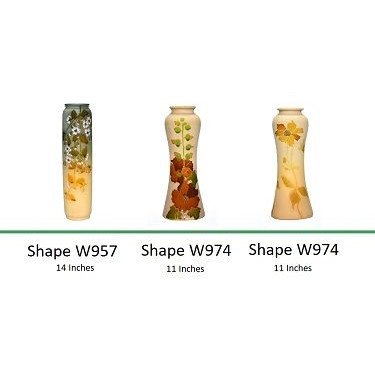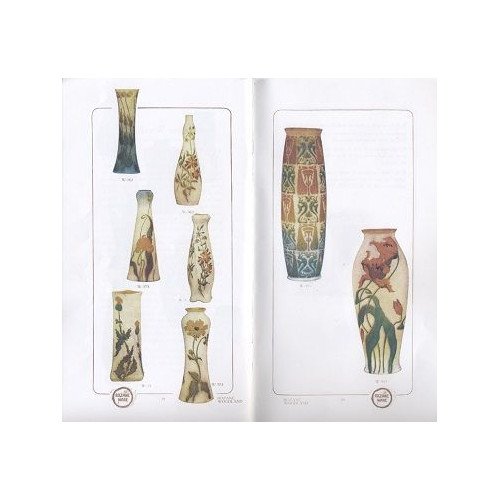
Collectors Guide to Roseville Pottery Rozane Woodland, 1905-1907
What is Woodland?
Woodland is a line of art pottery produced in 1905-1907 by the Roseville Pottery Company in Zanesville, Ohio.
Who designed Woodland?
The Woodland line was designed by Gazo Foudji.
The Rozane Woodland line was a natural extension of the 1905 Fujiyama line by Gazo Foudji. The vast majority of the shapes used were taken from the standard Rozane Royal line, changing only the designation from an "R" to an "W". Royal shape "R-971" became Woodland shape "W-971", and so on. The known shapes used include:
W807
W893
W933
W955
W957
W961
W969
W971
W972
W973
W974
W975
W978
W997
W998
W999
W2
W3
W6
W8
W15
Although we only know of examples of 21 different shapes, the actual total is likely much higher. 16 are shown in the 1905 Rozane pamphlet reproduced at the bottom of this page.
All Woodland is marked with the Rozane/Woodland wafer on the base. For decades collectors confused Woodland with Fujiyama. Both Fujiyama and Woodland are identified by different marks, with Fujiyama marked with a cursive ink-stamp. It is believed that most pieces of Fujiyama were executed by Gazo, but those on Woodland were copied from Gazo designs by other artists. In fact, it is not unusual to find Woodland signed by two artists, one who carved the designs and the other who applied the glazes. Like Fujiyama, each piece is normally considered unique, with a few rare examples where the same design was used twice. This makes collecting Woodland Rozane a very open-ended endeavor.
The Woodland Rozane line left the backgrounds an unglazed bisque, in varying hues from white to darker tans. Stripling was almost always present, and the applied bright glossy glazes covered the carvings of flowers and other flora.
When was Woodland made?
The Woodland line was only produced in 1905-1907.
Below are some examples of the Roseville Pottery Woodland line.
-

Rozaneware Woodland Mark
-

Woodland Shapes W973, W973, W15
-

Woodland Shapes W8, W972, W978
-

Woodland Shapes 957, W974, W974
-

Woodland Shapes W971, W961, W978
-

Woodland Shapes W15, W973, W807
-

Woodland Shapes W998, W972, W3
-

Rozane Woodland Brochure page 1
-

Rozane Woodland Brochure page 2
-

Rozane Woodland Brochure page 3

The following is the text of the 1905 Rozane pamphlet describing the Rozane Woodland line:
Rozane Woodland: Ancient Spirit in Modern Art
We do not deny that the resemblance of Rozane Woodland to one of the oldest and rarest of Chinese potteries is no accident. While Woodland is not an attempt at imitation of the old Chinese Celadon, familiarity with the latter, and with its exquisite qualities, was inspiration to the artist who created the idea of Rozane Woodland. Old Celadon, like Woodland, was decorated by incising either floral or conventional designs in the moist clay, or "biscuit" after moulding, and was further ornamented by studs or dots.
The old Celadon was very hard, opaque, closely akin to stoneware and covered with a partially translucent enamel. There were vases of gray earth, shading into browns and yellows and scattered with little laminae of mica, or sometimes picked with tiny points, almost imperceptible. The value of the old pieces in this style is almost inestimable.
The description of Rozane Woodland is almost identical with this of the old Chinese ware, except that Woodland has not the mica. The laminae mentioned, however, are daintily picked into the surface of the softly shaded mat background lending just an agreeable relief from its plainness, which is further broken by the dots or "studs," while the enameled designs stand out in pleasant contrast. The latter are usually in foliage hues, the browns resembling late autumn woodlands, when the thin , frost-exposed oak leaves (brown, mellow and glossy) still clinging, rustling in final glory, to the trees.
Rozane Woodland is exceptionally beautiful in every point that contributes to the excellence of an old art pottery. It is a pleasure to present this as our final argument for the true worth of Rozane.
A home with a piece of each Rozane variety will be possessed of a very representative collection of pottery, in good taste, decorative and useful.
Connoisseurs will find in every piece qualities which merit its being included in their collections of valuable art potteries.
We invite inspection of every variety and we are confident that one of our favorites, among all collectors and purchasers, will be ROZANE WOODLAND.
If you have more questions, we are certain you will find the answers in the following books. Each of these books is highly recommended for collectors of Roseville Pottery. The owners of this website may receive compensation for qualified sales of the books.




